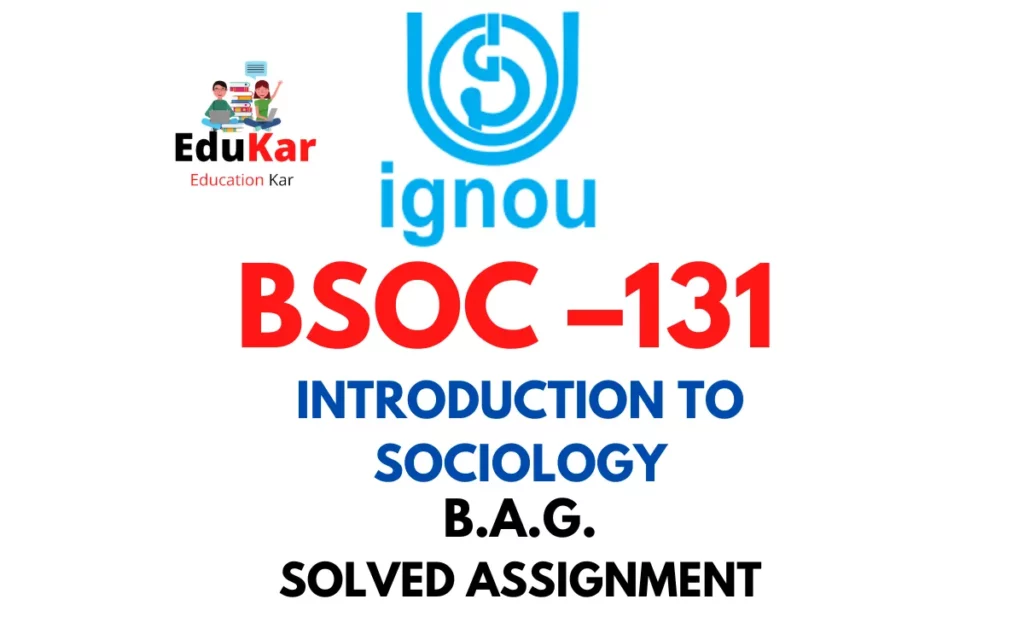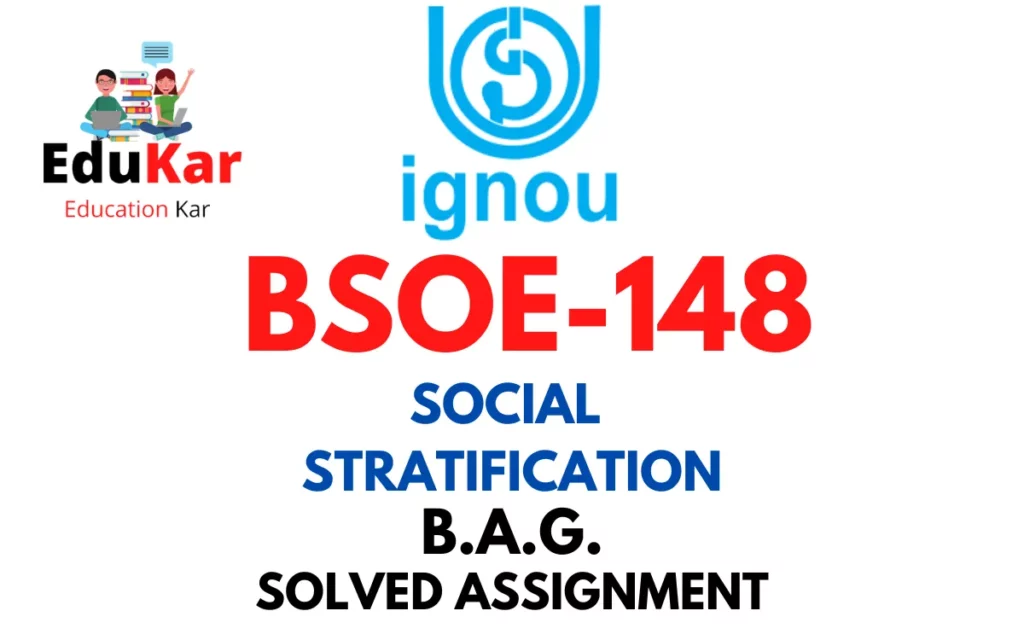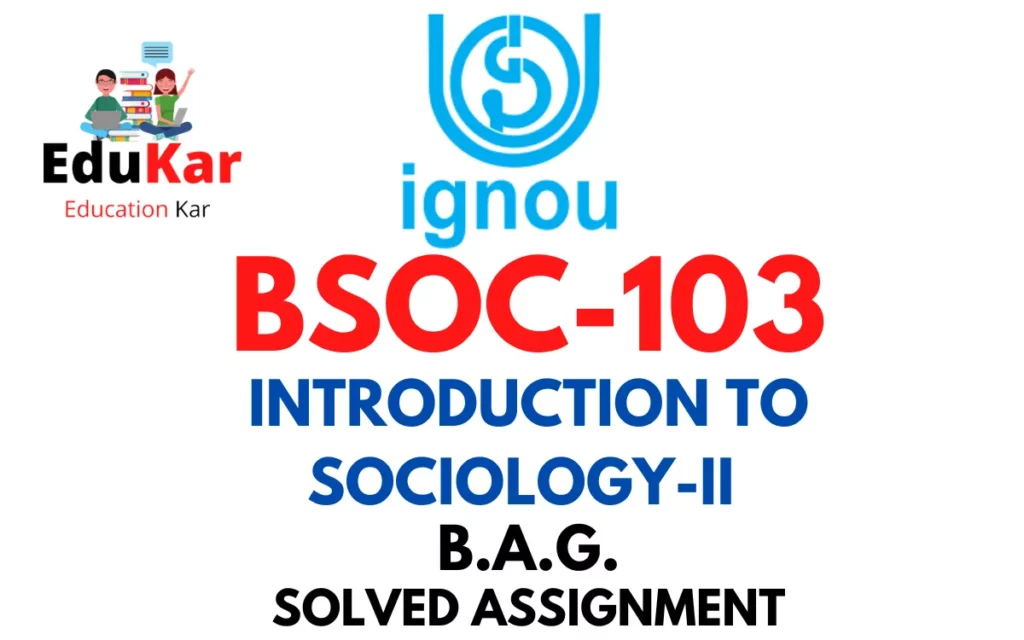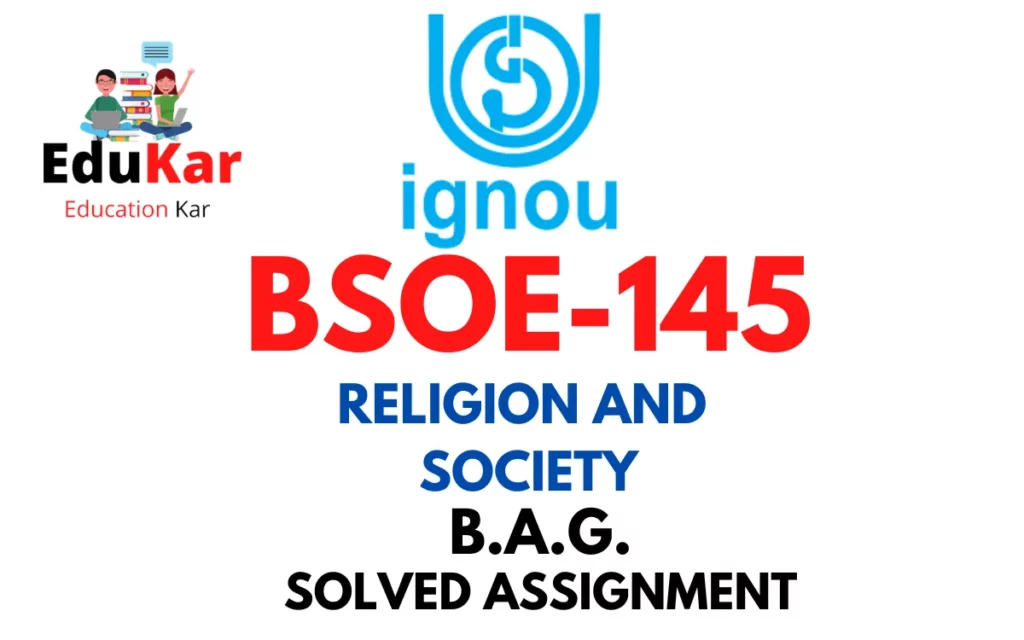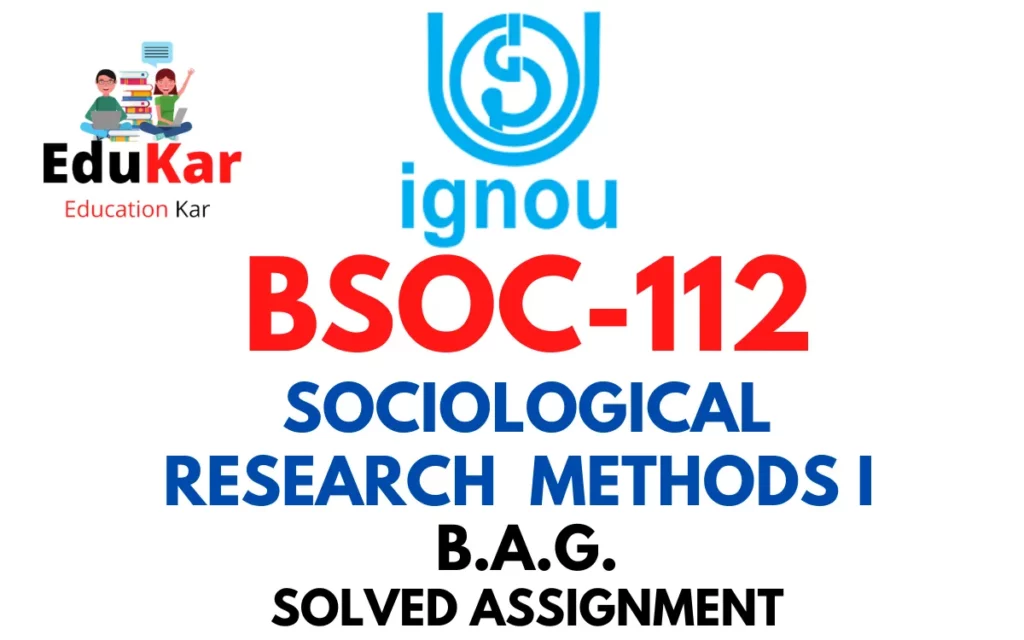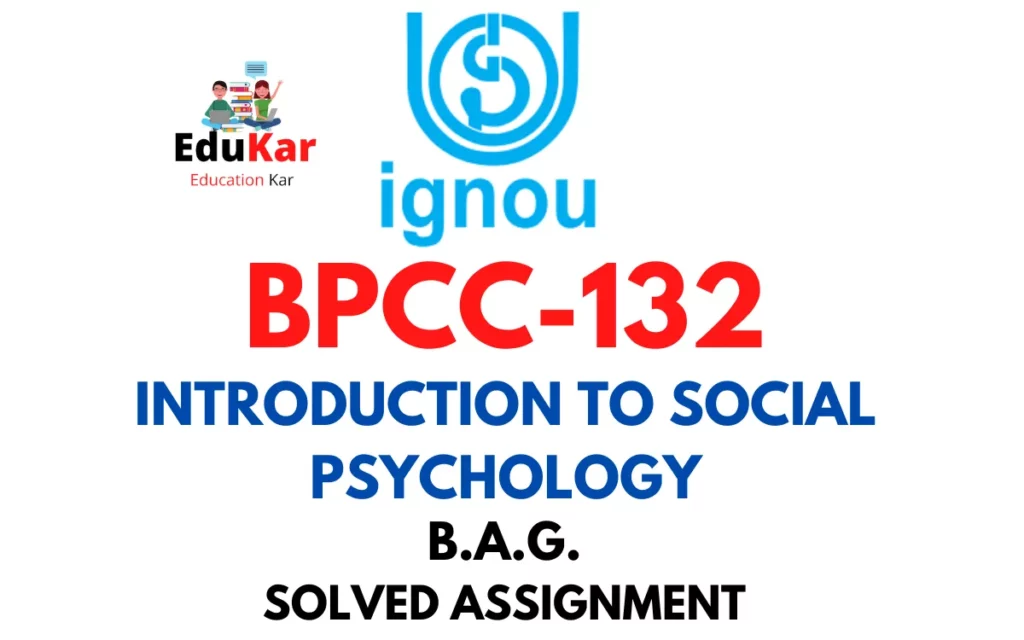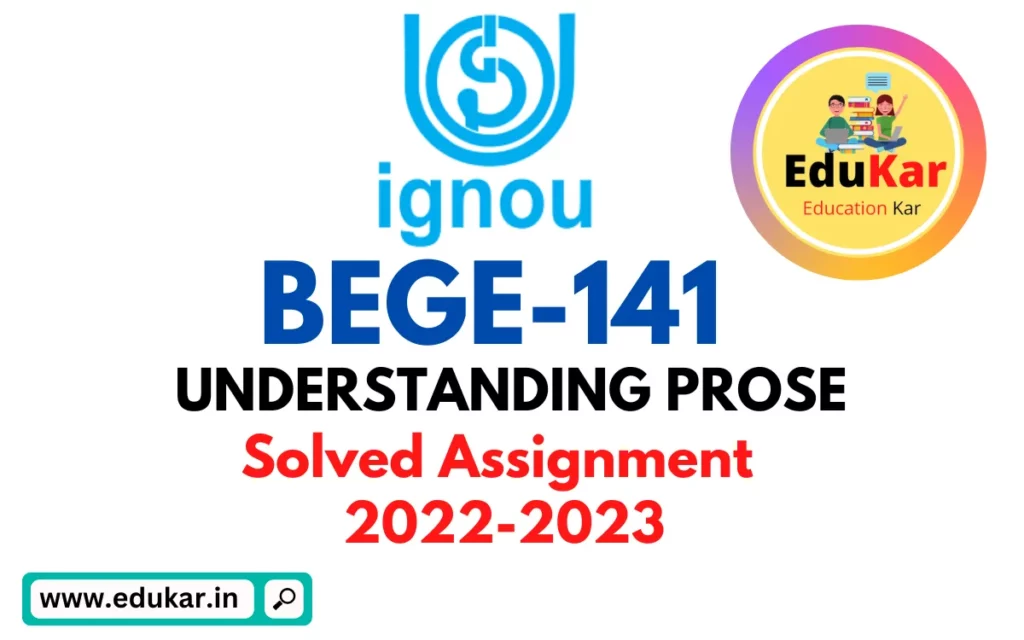Contents
- 1 Assignment – I
- 2 Answer the following in about 500 words each. ( Attempt any two questions from this part)
- 3 1) The genealogy and biography are important historical sources for the reconstruction of early medieval history. Discuss
- 4 2) Describe the polity and achievements of the Pala dynasty in the early medieval period.
- 5 3) Write an essay on the development of language and literature in the period from 750 to 1200 CE.
- 6 Assignment – II
- 7 Answer the following questions in about 250 words each.
- 8 4) Write a note on the Bhakti traditions of South India.
- 9 5) Describe the role of merchant associations in the growth of crafts, trade and urbanisation.
- 10 6) Discuss the social transformation and new social order in the early medieval period.
- 11 Assignment – III
- 12 Answer the following questions in about 100 words each.
- 13 7) Rethinking Feudalism
- 14 8) Literature and Drama
- 15 9) Spread in Indian Tradition
- 16 10) Cultural impact of Arab invasions
- 17 11) Chachnama.
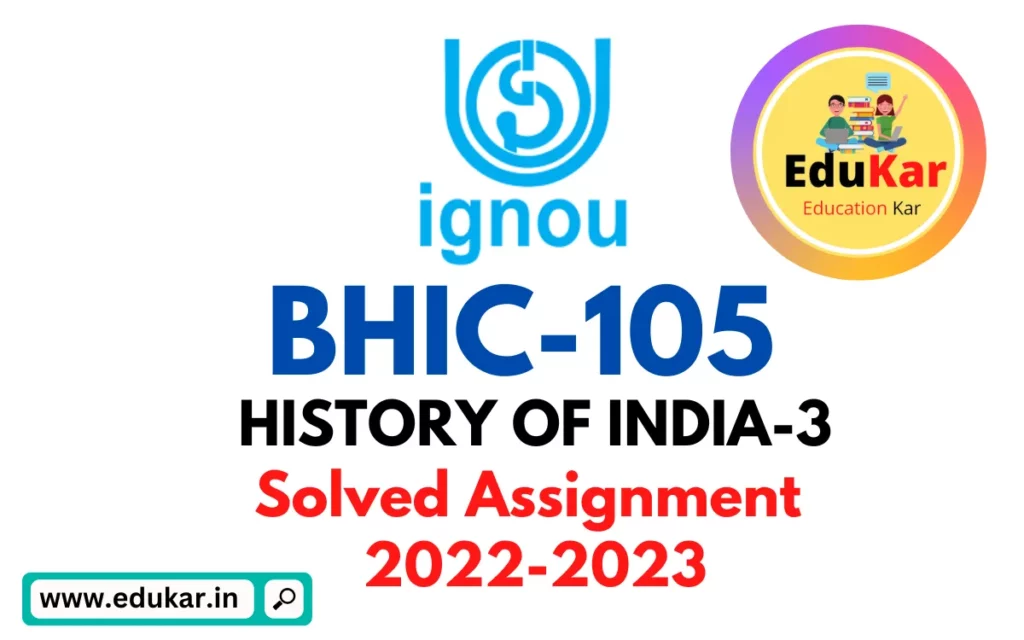
| Title | BHIC-105: IGNOU BAG Solved Assignment 2022-2023 |
| University | IGNOU |
| Degree | Bachelor Degree Programme |
| Course Code | BHIC-105 |
| Course Name | HISTORY OF INDIA-3 |
| Programme Name | Bachelor of Arts (General) |
| Programme Code | BAG |
| Total Marks | 100 |
| Year | 2022-2023 |
| Language | English |
| Assignment Code | BHIC-105/ASST/TMA/2022-23 |
| Last Date for Submission of Assignment: | For June Examination: 31st April For December Examination: 30th September |
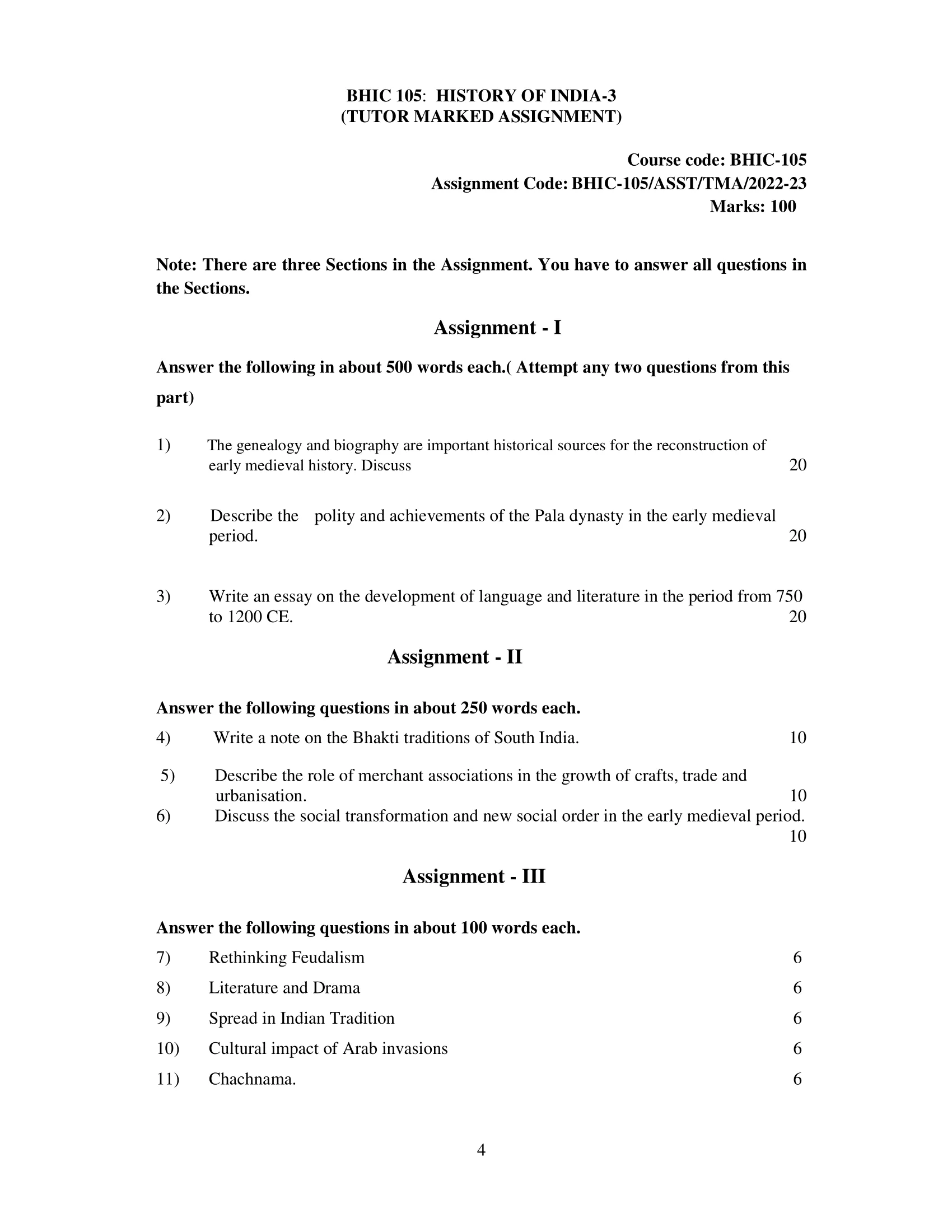
Assignment – I
Answer the following in about 500 words each. ( Attempt any two questions from this part)
1) The genealogy and biography are important historical sources for the reconstruction of early medieval history. Discuss
Ans: Genealogy and biography are critical sources for the reconstruction of early medieval history as they provide insight into the lives of individuals and their place within larger social structures. Genealogy, or the study of family lineages and relationships, offers valuable information on the nobility and their claims to power, as well as on the formation of political and economic ties through marriage and inheritance. Biography, on the other hand, focuses on the individual and provides a more intimate look at the life, personality, and achievements of a particular person.
During the early medieval period, genealogies were often recorded by monasteries and used to demonstrate the legitimacy of noble families and their claims to land and political power. These genealogies traced the ancestry of nobles back several generations and sometimes even further, connecting them to legendary figures or to historical events. By establishing a historical connection to a specific place or region, genealogies helped to reinforce the political and social stability of the area, demonstrating the continuity of the ruling dynasty and the legitimacy of its rule.
Biographies, on the other hand, offer a more personal look at the lives of individuals, including their beliefs, values, and motivations. Many early medieval biographies were written by monks and chroniclers, who often sought to promote the saints and heroes of their respective communities. These biographies provided not only historical information about the individuals but also moral and spiritual teachings, serving as models for the pious and demonstrating the power of the church.
Both genealogy and biography also provide insight into the cultural, economic, and social changes taking place during the early medieval period. For example, genealogies can reveal shifts in political power and alliances, while biographies can show how individuals responded to these changes and adapted to the new realities of their time. They also provide a window into the religious and cultural beliefs of the period, as well as into the customs, practices, and everyday life of the people.
2) Describe the polity and achievements of the Pala dynasty in the early medieval period.
Ans: The Pala dynasty was a major political force in India during the early medieval period, ruling over a large portion of the eastern part of the country from the 8th to the 12th centuries. The Palas were Buddhist in religion and are considered to be one of the golden ages of Buddhism in India. They were known for their military conquests, administrative achievements, and cultural patronage.
The Palas established a centralized administrative system and maintained a large standing army. They also fostered trade and commerce, and their rule saw the growth of many cities, including Nalanda, the center of Buddhist learning in ancient India. The Palas were also patrons of the arts, supporting the production of Buddhist texts and sculpture, and promoting the development of classical Indian music and dance.
One of the most notable achievements of the Pala dynasty was the growth of Buddhism during their rule. The Palas built many Buddhist monasteries and temples, including the famous Nalanda University, which was a center of Buddhist learning and one of the largest universities in the world at the time. They also patronized the production of Buddhist texts, including the famous Buddhist text, the “Mahavamsa”.
The Palas were also known for their military conquests, which extended their territories from Bengal to the Deccan Plateau in the south. They successfully defended their empire against Arab and Turkic invasions, and their army was led by skilled commanders such as Dharmapala and Devapala.
In addition to military achievements, the Palas also made significant contributions to Indian society, particularly in the fields of science, mathematics, and medicine. They also established a system of land grants to support the growth of Buddhism and encouraged the growth of agriculture, which led to increased food production and the growth of cities.
Despite the achievements of the Pala dynasty, their rule was not without challenges. Internal conflicts, particularly among members of the royal family, led to the eventual decline of the dynasty in the 12th century. Nevertheless, the Pala legacy lived on, and their cultural, religious, and political contributions continue to be felt in India to this day.
3) Write an essay on the development of language and literature in the period from 750 to 1200 CE.
Ans:
The period from 750 to 1200 CE saw the development of language and literature in several parts of the world, including the Islamic world, Europe, and East Asia. During this time, the rise of large empires and the spread of religion led to the growth of diverse cultures and the exchange of ideas and knowledge. As a result, language and literature played an important role in shaping the identity and cultural heritage of these civilizations.
In the Islamic world, the spread of Islam led to the development of a shared language and culture among the diverse peoples of the empire. Arabic became the lingua franca of the Islamic world, and its development was greatly influenced by the translation of Greek, Persian, and Indian works into Arabic. This led to the growth of Arabic literature, including poetry, philosophy, and science, as well as the development of a rich oral tradition in the form of storytelling and the transmission of religious knowledge. The works of scholars such as al-Mutanabbi, al-Farabi, and al-Razi had a profound impact on the Islamic world and continue to be studied and revered to this day.
In Europe, the period from 750 to 1200 saw the growth of the Old French language and the development of a rich tradition of poetry, song, and storytelling. The works of writers such as Chretien de Troyes, Marie de France, and the anonymous poet who wrote the epic “Beowulf” reflect the changing cultural, political, and religious landscape of medieval Europe. These works, which were often written in a courtly and refined style, are seen as the foundation of European literature and continue to be studied and celebrated.
In East Asia, the period from 750 to 1200 saw the growth of several languages and literary traditions, including Chinese, Japanese, and Korean. During this time, China was ruled by the Tang dynasty, which was known for its patronage of the arts and the growth of a cosmopolitan culture. The Tang period saw the growth of Chinese poetry, including the works of Li Bai, Du Fu, and Wang Wei, which are considered to be among the greatest works of Chinese literature.
In Japan, the Heian period, which lasted from 794 to 1185, saw the growth of the Japanese language and the development of a rich tradition of poetry, fiction, and diary writing. The works of writers such as Sei Shonagon and Murasaki Shikibu, who wrote “The Tale of Genji”, are considered to be among the greatest works of Japanese literature and continue to be studied and celebrated to this day.
Assignment – II
Answer the following questions in about 250 words each.
4) Write a note on the Bhakti traditions of South India.
Ans: The Bhakti traditions of South India refer to a form of devotional Hinduism that emerged in the region during the medieval period. This movement emphasized the importance of personal devotion to a deity, and the direct relationship between the devotee and the divine. Bhakti traditions in South India were centered around devotional songs, which were sung in regional languages and were meant to evoke feelings of love and devotion towards the deity.
One of the most prominent Bhakti traditions in South India was the devotional cult of Lord Vishnu, which was propagated by the Alvars and Nayanars, two groups of saints who sang hymns in praise of the deity. These hymns, which were written in regional languages such as Tamil and Sanskrit, were considered to be powerful expressions of devotion and helped to spread the Bhakti movement.
Another important Bhakti tradition in South India was the devotional cult of Lord Shiva, which was propagated by the Nayanars and later by the Lingayats, who followed the teachings of the philosopher Basavanna. This tradition emphasized the importance of devotion and the worship of the lingam, a symbol of Lord Shiva.
Bhakti traditions in South India had a profound impact on the region, shaping its culture and religion and influencing later developments in Hinduism. These traditions emphasized the importance of devotion, compassion, and love, and they helped to create a sense of community and belonging among the devotees. They also contributed to the growth of regional languages and literature, and their devotional songs continue to be sung and celebrated to this day.
5) Describe the role of merchant associations in the growth of crafts, trade and urbanisation.
Ans: Merchant associations played a crucial role in the growth of crafts, trade, and urbanization in many societies throughout history. Merchant associations were groups of merchants who joined together for mutual support and protection, and they often had significant economic and political power. They were active in the development of trade and commerce, and they helped to create an environment that was favorable to the growth of crafts and urbanization.
Merchant associations provided a platform for the exchange of information and the development of trade networks. They facilitated the exchange of goods and services, and they provided a means for merchants to negotiate and coordinate their activities. They also helped to regulate trade and to resolve disputes between merchants, ensuring that trade was conducted in a fair and orderly manner.
In many cases, merchant associations also played a role in the development of crafts and the growth of urban centers. They provided support to craftsmen and entrepreneurs, financing their businesses and helping to expand their markets. They also helped to create an environment that was favorable to the growth of crafts, by encouraging the development of new techniques and technologies and by providing training and apprenticeships for young craftsmen.
Urbanization was also closely linked to the growth of merchant associations. As trade networks expanded and cities grew, merchant associations became a major force in the development of urban centers. They played a role in shaping the physical and cultural landscape of cities, financing the construction of public buildings, marketplaces, and other infrastructure, and promoting cultural and religious activities. They also helped to create a sense of community among the residents of cities, providing support and protection to their members and helping to build a sense of shared identity.
Ans: The early medieval period in India, between the 6th and 12th centuries, saw significant social transformation and the emergence of a new social order. This period was marked by the decline of the Gupta Empire and the rise of regional kingdoms, as well as the influence of foreign cultures and religions, including Buddhism, Hinduism, and Islam. These changes had a profound impact on the social structure of India, leading to the formation of a new social order that was characterized by new forms of caste, class, and regional identities.
One of the most significant social transformations of this period was the emergence of the caste system. The caste system, which had its roots in the Hindu social order, became more rigid and hierarchical during this period, with the emergence of new castes and the strengthening of existing ones. The caste system was used to define social status and to regulate access to resources and opportunities, and it had a profound impact on the social and economic lives of the people of India.
Another important social transformation of this period was the growth of urbanization. The rise of trade and commerce, as well as the growth of agriculture and other forms of economic activity, led to the development of cities and towns, which became centers of trade, culture, and politics. The growth of urbanization brought about significant changes in social relationships and cultural practices, as people from different regions and castes came into contact with one another in the cities.
Assignment – III
Answer the following questions in about 100 words each.
7) Rethinking Feudalism
Ans: Rethinking Feudalism is a concept in medieval history and refers to a reassessment of the traditional understanding of feudalism and its role in the development of medieval societies. This approach challenges the traditional view of feudalism as a rigid and hierarchical system of lords and vassals, and instead argues that feudal relationships were more complex, fluid, and negotiated.
Rethinking Feudalism emphasizes the importance of local context and the agency of individuals and communities in shaping feudal relationships. It argues that feudal relationships were not simply imposed from above, but were the result of negotiations between lords and vassals, and that these relationships were shaped by factors such as local politics, economic interests, and social norms.
8) Literature and Drama
Ans: Literature and drama are two important forms of artistic expression that have been developed and enjoyed by people throughout history. They offer a way to engage with the world, to explore human experiences, emotions, and relationships, and to reflect on the human condition.
Literature is a form of written artistic expression that can take many different forms, including poetry, prose fiction, and non-fiction. It allows writers to express their thoughts, feelings, and ideas, and to explore the world around them. Through literature, writers can address a wide range of themes, including love, loss, war, and politics, and they can use language to create vivid and memorable characters, settings, and plot lines.
Drama, on the other hand, is a form of performance art that is typically performed on stage. It is characterized by its use of dialogue, acting, and stagecraft, and it often explores the same themes and subjects as literature. Drama can be performed in a variety of styles, including tragedy, comedy, and musicals, and it can take many different forms, including plays, operas, and musicals.
9) Spread in Indian Tradition
Ans: Literature and drama have a long and rich tradition in India, and have been a significant part of the cultural heritage of the country for centuries. From ancient Sanskrit plays and epic poems, to modern-day Bollywood movies and contemporary literature, literature and drama have played an important role in Indian society and have reflected the changing attitudes and values of the country over time.
In ancient India, Sanskrit literature, including the epics “Ramayana” and “Mahabharata”, was widely read and performed, and it was seen as a means of preserving and transmitting cultural values and traditions. Sanskrit drama, such as the plays of Kalidasa, was also highly regarded and was performed in courtly circles and in temple festivals.
10) Cultural impact of Arab invasions
Ans: The Arab invasions of the 7th and 8th centuries had a profound impact on the culture and civilization of the regions they conquered, including the Indian subcontinent. The Arab armies brought with them the culture, religion, and language of the Arabian Peninsula, and these elements quickly became part of the local cultures of the areas they conquered.
One of the most significant cultural impacts of the Arab invasions was the spread of Islam. The Arab armies were motivated by a desire to spread their religion, and they quickly established Muslim communities in the regions they conquered. Over time, many local populations converted to Islam, and the religion became deeply embedded in the cultural and social fabric of the region.
11) Chachnama.
Ans: The Chachnama is a medieval Persian text that was written in the 13th century and provides a history of the Arab conquest of Sindh (present-day Pakistan) in the 8th century. The text is considered to be one of the earliest and most important historical sources for the Arab conquest of the region and provides a unique perspective on the events of that time.
The Chachnama is written in Persian, and it is believed to have been composed by a historian or scholar who was knowledgeable about the history of the region. The text is structured as a narrative and provides a detailed account of the Arab conquest of Sindh, including the events leading up to the conquest, the military campaigns, and the subsequent administration of the region.
How to Download BHIC-105 Solved Assignment?
You can download it from the www.edukar.in, they have a big database for all the IGNOU solved assignments.
Is the BHIC-105 Solved Assignment Free?
Yes this is absolutely free to download the solved assignment from www.edukar.in
What is the last submission date for BHIC-105 Solved Assignment?
For June Examination: 31st April, For December Examination: 30th October


